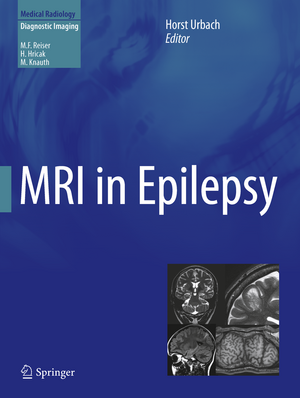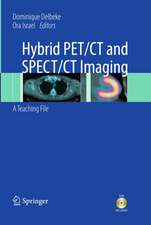MRI in Epilepsy: Medical Radiology
Editat de Horst Urbachen Limba Engleză Hardback – 4 iun 2013
| Toate formatele și edițiile | Preț | Express |
|---|---|---|
| Paperback (1) | 914.32 lei 6-8 săpt. | |
| Springer Berlin, Heidelberg – 22 mai 2015 | 914.32 lei 6-8 săpt. | |
| Hardback (1) | 1307.85 lei 3-5 săpt. | |
| Springer Berlin, Heidelberg – 4 iun 2013 | 1307.85 lei 3-5 săpt. |
Din seria Medical Radiology
- 5%
 Preț: 1108.87 lei
Preț: 1108.87 lei - 5%
 Preț: 349.23 lei
Preț: 349.23 lei - 5%
 Preț: 1308.02 lei
Preț: 1308.02 lei - 5%
 Preț: 1308.74 lei
Preț: 1308.74 lei - 5%
 Preț: 720.68 lei
Preț: 720.68 lei - 5%
 Preț: 717.20 lei
Preț: 717.20 lei - 5%
 Preț: 1626.03 lei
Preț: 1626.03 lei - 5%
 Preț: 1618.70 lei
Preț: 1618.70 lei - 5%
 Preț: 802.21 lei
Preț: 802.21 lei - 5%
 Preț: 1130.07 lei
Preț: 1130.07 lei - 5%
 Preț: 1116.00 lei
Preț: 1116.00 lei - 5%
 Preț: 1953.34 lei
Preț: 1953.34 lei - 5%
 Preț: 783.04 lei
Preț: 783.04 lei - 5%
 Preț: 1105.61 lei
Preț: 1105.61 lei - 5%
 Preț: 794.00 lei
Preț: 794.00 lei - 5%
 Preț: 1101.21 lei
Preț: 1101.21 lei - 5%
 Preț: 821.18 lei
Preț: 821.18 lei - 5%
 Preț: 1420.29 lei
Preț: 1420.29 lei - 5%
 Preț: 743.16 lei
Preț: 743.16 lei - 5%
 Preț: 906.63 lei
Preț: 906.63 lei - 5%
 Preț: 1313.72 lei
Preț: 1313.72 lei - 5%
 Preț: 1858.27 lei
Preț: 1858.27 lei - 5%
 Preț: 1306.73 lei
Preț: 1306.73 lei - 5%
 Preț: 1113.11 lei
Preț: 1113.11 lei - 5%
 Preț: 1462.37 lei
Preț: 1462.37 lei - 5%
 Preț: 1301.44 lei
Preț: 1301.44 lei - 5%
 Preț: 975.17 lei
Preț: 975.17 lei - 5%
 Preț: 1122.58 lei
Preț: 1122.58 lei - 5%
 Preț: 1986.27 lei
Preț: 1986.27 lei - 5%
 Preț: 1126.82 lei
Preț: 1126.82 lei - 5%
 Preț: 718.46 lei
Preț: 718.46 lei - 5%
 Preț: 1450.84 lei
Preț: 1450.84 lei - 5%
 Preț: 1298.14 lei
Preț: 1298.14 lei - 5%
 Preț: 1110.32 lei
Preț: 1110.32 lei - 5%
 Preț: 1184.42 lei
Preț: 1184.42 lei - 5%
 Preț: 1113.99 lei
Preț: 1113.99 lei - 5%
 Preț: 1435.85 lei
Preț: 1435.85 lei - 5%
 Preț: 663.23 lei
Preț: 663.23 lei - 5%
 Preț: 1605.08 lei
Preț: 1605.08 lei - 5%
 Preț: 731.07 lei
Preț: 731.07 lei - 5%
 Preț: 733.09 lei
Preț: 733.09 lei - 5%
 Preț: 1124.07 lei
Preț: 1124.07 lei - 5%
 Preț: 383.93 lei
Preț: 383.93 lei - 5%
 Preț: 1106.69 lei
Preț: 1106.69 lei - 5%
 Preț: 982.50 lei
Preț: 982.50 lei - 5%
 Preț: 1317.17 lei
Preț: 1317.17 lei - 5%
 Preț: 1437.67 lei
Preț: 1437.67 lei - 5%
 Preț: 1950.60 lei
Preț: 1950.60 lei
Preț: 1307.85 lei
Preț vechi: 1376.69 lei
-5% Nou
Puncte Express: 1962
Preț estimativ în valută:
250.25€ • 261.28$ • 207.12£
250.25€ • 261.28$ • 207.12£
Carte disponibilă
Livrare economică 14-28 martie
Preluare comenzi: 021 569.72.76
Specificații
ISBN-13: 9783642251375
ISBN-10: 3642251374
Pagini: 280
Ilustrații: XIII, 270 p.
Dimensiuni: 210 x 279 x 20 mm
Greutate: 1.02 kg
Ediția:2013
Editura: Springer Berlin, Heidelberg
Colecția Springer
Seriile Medical Radiology, Diagnostic Imaging
Locul publicării:Berlin, Heidelberg, Germany
ISBN-10: 3642251374
Pagini: 280
Ilustrații: XIII, 270 p.
Dimensiuni: 210 x 279 x 20 mm
Greutate: 1.02 kg
Ediția:2013
Editura: Springer Berlin, Heidelberg
Colecția Springer
Seriile Medical Radiology, Diagnostic Imaging
Locul publicării:Berlin, Heidelberg, Germany
Public țintă
Professional/practitionerCuprins
Epileptic Seizure and Epilepsy.- Classification of epileptic seizures.- Description of focal seizures.- Description of generalized seizures.- Classification of epilepsy syndroms.-Definition of the term epileptogenic lesion and how to use it.- What to do after a first seizure.-Febrile seizures.- How to perform a MRI examination.- Functional Imaging and Post-Processing.- Examination of children.- Examination of patients with intracranial electrodes and other metallic implants.- Congenital malformations,- neurocutaneous diseases.- Posttraumatic lesions.- Vascular lesions.- Infections.
Recenzii
“This is an excellent MR atlas of acquired, metabolic, MELAS, congenital, pediatric, parasitic, infectious (bacterial & viral) AIDS, and tumorous lesions affecting cerebral cortical, white matter, and brainstem function. … I recommend this book to neurosurgeons, neuropathologists, neurologists, and researchers. Pediatic surgeons will also find the text/atlas helpful. It is very detailed with a large number of MR images in a case study format.” (Joseph J. Grenier, Amazon.com, July, 2015)
“This book is very well organized and very easy to read. … The editor of MRI in Epilepsy has put together a comprehensive list of epileptogenic lesions, with information on how to image them and how to correlate them with the clinical picture. … this book is a practical guide to help us better image these lesions and be more sensitive to them, so as to provide better services to our patients with epilepsy.” (Earn Chun Christabel Lee, Radiology, Vol. 272 (2), August, 2014)
“This multi-author monograph from the reputable publishing house Springer is a timely contribution to this field. … The chapters are well referenced for those who want further details. The book is an excellent scholarly contribution to the field of epilepsy imaging and will serve as a useful reference to be dipped in and out of by all who encounter these investigations in their clinical practice.” (Arpan K. Banerjee, RAD Magazine, January, 2014)
“This book is very well organized and very easy to read. … The editor of MRI in Epilepsy has put together a comprehensive list of epileptogenic lesions, with information on how to image them and how to correlate them with the clinical picture. … this book is a practical guide to help us better image these lesions and be more sensitive to them, so as to provide better services to our patients with epilepsy.” (Earn Chun Christabel Lee, Radiology, Vol. 272 (2), August, 2014)
“This multi-author monograph from the reputable publishing house Springer is a timely contribution to this field. … The chapters are well referenced for those who want further details. The book is an excellent scholarly contribution to the field of epilepsy imaging and will serve as a useful reference to be dipped in and out of by all who encounter these investigations in their clinical practice.” (Arpan K. Banerjee, RAD Magazine, January, 2014)
Textul de pe ultima copertă
Epileptogenic lesions are often small and do not change over time. Moreover, several genetically determined epilepsy syndromes exist, and by definition are not caused by underlying structural lesions. As a result of these circumstances, there is frequently a degree of uncertainty over whether an epileptogenic lesion is being overlooked or simply is not present. MRI can play an important role in resolving such uncertainty and localizing epileptogenic foci.
This book aims to provide the clinical and imaging information required in order to decide whether an MRI scan is appropriate and whether it is likely to be sufficient to detect a lesion. The first part of the book presents background information on epilepsy and explains how to perform an MRI examination. Detailed attention is paid to functional MRI and post-processing, and the examination of subcategories of patients is also discussed. The second part of the book then documents the MRI findings obtained in the full range of epileptogenic lesions with the aid of high-quality images. Throughout, emphasis is placed on guiding the reader in the correct interpretation of the imaging findings. Both radiologists and referring physicians will find this book to be an indispensable guide to the optimal use of MRI in epilepsy.
This book aims to provide the clinical and imaging information required in order to decide whether an MRI scan is appropriate and whether it is likely to be sufficient to detect a lesion. The first part of the book presents background information on epilepsy and explains how to perform an MRI examination. Detailed attention is paid to functional MRI and post-processing, and the examination of subcategories of patients is also discussed. The second part of the book then documents the MRI findings obtained in the full range of epileptogenic lesions with the aid of high-quality images. Throughout, emphasis is placed on guiding the reader in the correct interpretation of the imaging findings. Both radiologists and referring physicians will find this book to be an indispensable guide to the optimal use of MRI in epilepsy.
Caracteristici
Detailed guide to the use of MRI in epilepsy Clearly relates clinical information to imaging findings Emphasis on high-resolution and functional MRI Edited by an expert who has supervised MRI in one of the world’s largest epilepsy surgery centers for more than 10 years Includes supplementary material: sn.pub/extras















